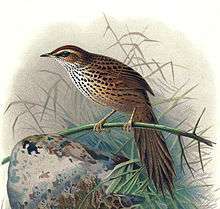New Zealand fernbird
| New Zealand fernbird | |
|---|---|
 | |
| Scientific classification | |
| Kingdom: | Animalia |
| Phylum: | Chordata |
| Class: | Aves |
| Order: | Passeriformes |
| Family: | Locustellidae |
| Genus: | Megalurus |
| Species: | M. punctatus |
| Binomial name | |
| Megalurus punctatus (Quoy & Gaimard, 1830) | |
| Synonyms | |
|
Bowdleria punctata | |
The New Zealand fernbird or simply fernbird (Megalurus punctatus) is an insectivorous bird endemic to New Zealand. The Māori names are kōtātā or mātātā. It is a rich brown above and white below, with brown spots on both the throat and breast. Early settlers called it the "swamp sparrow" no doubt because of its colouration.[2] The tail feathers are thin, dark brown, and spine-like. The birds reach a length of 18 cm (7 in) - as measured from tip of beak to end of tail. However,almost half of that is tail[2]
The New Zealand fernbird is a ground-dwelling bird, and is a reluctant flier, travelling mainly on foot or in occasional short flights of less than 15 metres. In the 19th century Buller described it as "one of our most common"[2] (birds) but it has been adversely affected by the subsequent widespread destruction of its natural (wetland) habitat following European settlement and is now rare[2]
There are six fully protected sub-species of New Zealand fernbird:
- M. p. punctatus (South Island fernbird)
- M. p. vealeae (North Island fernbird)
- M. p. stewartianus (Stewart Island fernbird)
- M. p. wilsoni (Codfish Island fernbird)
- M. p. caudatus (Snares fernbird)
Megalurus rufescens (the Chatham fernbird) is believed to have become extinct circa 1900.
The birds nest in sedges or other vegetation close to the ground, making a deep woven cup of dried rushes lined with feathers. Breeding occurs from September to February, producing clutches of 2-3 pinkish-white eggs with brown or purple speckles.
Place in Māori culture
Māori revered the fernbird as an "oracle" or "Wise bird" (Manu tohu).[2] The calls of the bird were interpreted as heralding success or failure in daily activities such as fishing but on a more serious level could also portend prosperity and health or disaster and death.[2]
References
- ↑ BirdLife International (2012). "Bowdleria punctata". IUCN Red List of Threatened Species. Version 2013.2. International Union for Conservation of Nature. Retrieved 26 November 2013.
- 1 2 3 4 5 6 "Wetlands of New Zealand; A Bitter-Sweet story", Janet Hunt, Random House, 2007
- Falla, R.A., Sibson, R.B., and Turbott, E.G. (1970). A Field Guide to the Birds of New Zealand. London: Collins. ISBN 0-00-212022-4
- Marshall, J., Kinsky, F.C., and Robinson, C.J.R. (1982). The Fiat Book of Common birds in New Zealand. Wellington: A.H. and A.W. Reed. ISBN 0-589-00759-9

